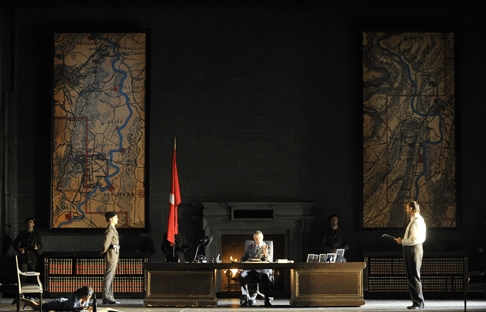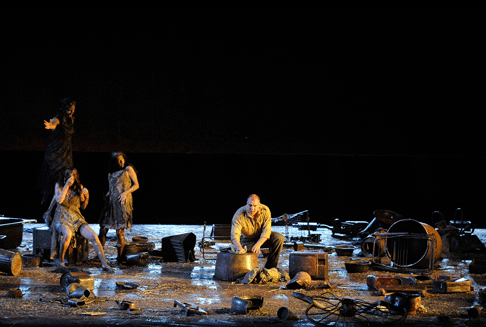La Fenice’s Ring, however, will not be
completed until next season because of complicated programming and budgeting
considerations. Consequently, the prologue, Das Rheingold, will be
seen in the lagoon after the downfall of the Gods and of the Gibichungs’
Kingdom. Moreover, although the Carsen-Kinmonth-Tate team remained unchanged,
many cast changes were made at La Fenice along with a revamping of the sets to
fit its smaller stage.
Chronologically, the Kˆln-La Fenice Ring is one of the first
to be staged in the 21st century. Its concepts are similar to those of the
“politically oriented” Rings that prevailed from the
mid-70s to the mid-80s, especially in Europe. This first of these
“politically oriented” Rings was the (nearly aborted) La
Scala production created by Luca Ronconi (stage direction) and the Pierluigi
Pizzi (sets and costumes) in 1974. The musical director, Wolfang Sawallisch,
objected to proceeding beyond Die Walk¸re. The entire project was revived
in Florence (with Zubin Mehta in the pit) in 1979-82. The most widely known of
the “politically oriented” Rings was the Bayreuth
“Centenary” production in 1976 entrusted to Patrice ChÈreau and
Pierre Boulez. After four years in the “Holy Hill”, it became a
successful television serial that was also shown in regular movie houses. Now
whilst only photographs remain of the Florence production, the ChÈreau-Boulez
Ring is available on DVD. It is fair to say that the saga lends itself
to a political allegory of industrial and political power, of lust for money
and for women, of Nazism’s rise and fall, a direction taken by Luchino
Visconti in his 1971 blockbuster film.
In light of this context, there is something old fashioned in the La Fenice-Kˆln production. Nevertheless, the Ghibichung Kingdom is not Hitler’s
Reich, but rather East Germany before the fall of the Berlin Wall. Red flags
are flying about the Royal Palace. The “nomenklatura” are dressed
in elegant attire of the ’50s, accompanied by soldiers of the National
Peoples’ Army. Siegfried, Br¸nnhilde and the Norns, on the other hand,
are shabbily dressed. The Norns live in an attic filled with broken
furniture from the 1930s and the 1940s (an allusion to the defunct
bourgeoisie?).
Albeit attractive, the Rhinemaidens appear poverty-striken,
swimming in a polluted Rhine. As in many of Carsen’s production, politics
is mixed with a fair amount of sex. At daybreak, Br¸nnhilde begins her
passionate love duet by performing oral sex upon Siegfried. Hagen makes love to
Gutrune on Gunther’s royal desk (in the presence of her brother and
King). In the wife-swapping scene at the end of the first act, Siegfried
(disguised as Gunther) attempts to rape Br¸nnhilde before remembering his pact
with the King. The second-act wedding party initially appears as an orgy with
rivers of wine and spirits and ladies taking off their clothes.

In a similar
vein, the Rheinmaidens grope Siegfried all about his trousers. All of this heightens the coup-de-thÈ‚tre in the final scene. Br¸nnhilde is alone
on stage during the holocaust, the fire of the Royal Palace, the downfall of
the Gods and the flood of the river (cleansing corrupted Gods and corrupted
men-in-power). During the concluding passages, a huge waterfall covers the
stage. In short, although the concept goes back to the 70s, there are numerous
innovations in this Ring and this Gˆtterd‰mmerung in
particular.

Although British, Jeffrey Tate possesses an Italian or Austrian conducting
style. He caresses the orchestra with gently slowing tempi. This clashes,
however, with the dramatic action-oriented stage direction. La Fenice’s
orchestra fares well; but it is not that of the Maggio Musicale Fiorentino
(which performed Gˆtterd‰mmerung a few weeks ago) or of the Berliner
Philarmoniker (which will perform Gˆtterd‰mmerung in Aix en Provence
in early July). Jayne Casselman was simply excellent, both vocally and
dramatically, as a vibrant Br¸nnhilde to be remembered for some time. Her
Siegfried, Stefan Vinke, performed well in the taxing third act; but in the
previous two acts he displayed vocal problems (especially with the Cs) and a
host of technical difficulties. He paled against Lance Taylor who performed the
role in the recent Florence production. A sexy Nicola Beller Carbone was a
vocally imposing Gutrune. And, the youthful Gabriel Suovane and Gidon Saks were
two well-rounded bass baritones, whom, I trust, we will hear often in the
future.
Giuseppe Pennisi
image=http://www.operatoday.com/Gotterdammerung_Fenice_02.gif
image_description=Jayne Casselman as Br¸nnhilde [Photo courtesy of Teatro La Fenice]
product=yes
product_title=Richard Wagner: Gˆtterd‰mmerung
product_by=Siegfried: Stefan Vinke; Gunther: Gabriel Suovanen; Hagen: Gidon Saks; Alberich: Werner Van Mechelen; Br¸nnhilde: Jayne Casselman; Gutrune: Nicola Beller Carbone; Waltraute: Natascha Petrinsky; First Norn: Ceri Williams; Second Norn: Julie Mellor; Third Norn: Alexandra Wilson; Woglinde: Eva Oltiv·nyi; Wellgunde: Stefanie Ir·nyi; Flosshilde: Annette Jahns. Orchestra e Coro del Teatro La Fenice. Voxonus Choir. Jeffrey Tate, maestro concertatore e direttore. Robert Carsen, regia. Patrick Kinmonth, scene e costumi. Marcovalerio Marletta, maestro del Coro. Claudio Marino Moretti, maestro del Coro (Voxonus Choir).
product_id=Above: Jayne Casselman as Br¸nnhilde [Photos courtesy of Teatro La Fenice]